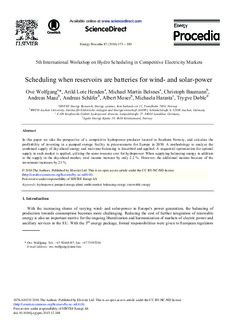| dc.contributor.author | Wolfgang, Ove | |
| dc.contributor.author | Henden, Arild Lothe | |
| dc.contributor.author | Belsnes, Michael Martin | |
| dc.contributor.author | Baumann, Christoph | |
| dc.contributor.author | Maaz, Andreas | |
| dc.contributor.author | Schäfer, Andreas | |
| dc.contributor.author | Moser, Albert | |
| dc.contributor.author | Harasta, Michaela | |
| dc.contributor.author | Døble, Trygve | |
| dc.date.accessioned | 2016-02-04T10:17:02Z | |
| dc.date.accessioned | 2016-07-28T11:48:44Z | |
| dc.date.available | 2016-02-04T10:17:02Z | |
| dc.date.available | 2016-07-28T11:48:44Z | |
| dc.date.issued | 2016 | |
| dc.identifier.citation | Energy Procedia 2016, 87:173-180 | |
| dc.identifier.issn | 1876-6102 | |
| dc.identifier.uri | http://hdl.handle.net/11250/2397352 | |
| dc.description | - | |
| dc.description.abstract | In this paper we take the perspective of a competitive hydropower producer located in Southern Norway, and calculate the profitability of investing in a pumped storage facility in price-scenario for Europe in 2050. A methodology to analyze the combined supply of day-ahead energy and real-time balancing is described and applied. A sequential optimization for optimal supply in each market is applied, utilizing the same resource cost for hydropower. When supplying balancing energy in addition to the supply in the day-ahead market, total income increase by only 2.2%. However, the additional income because of the investment increases by 21%. | |
| dc.language.iso | eng | |
| dc.title | Scheduling when Reservoirs are Batteries for Wind- and Solar-power | |
| dc.type | Journal article | |
| dc.type | Peer reviewed | |
| dc.date.updated | 2016-02-04T10:17:02Z | |
| dc.identifier.doi | 10.1016/j.egypro.2015.12.348 | |
| dc.identifier.cristin | 1331921 | |
